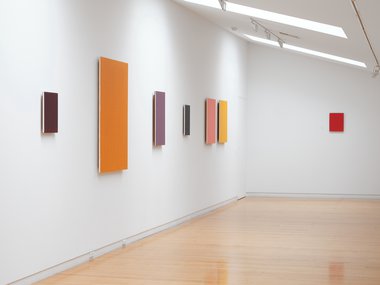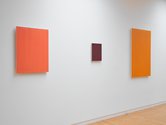John Hurrell – 13 July, 2022
You would never mistake these for monochromes. So while some, like the yellow works, emphasise perhaps (in your imagination) vertical stalks or a forest of tree trunks; others like the red ones, have a strong horizontal texture that exacerbates the sense of a woven picture-plane, the lateral drift almost dominating the field. This tension is intriguing, and repeatedly draws you back, with vertically fingered subtraction deftly co-ordinating with horizontally brushed additive processes in a satisfying manner.
Upstairs in the narrow Two Rooms gallery Noel Ivanoff presents a dozen of what he calls ‘digit’ paintings, moderately sized vertical rectangular panels with opaque wet paint partially removed through a finger moving along a template edge to create a subtle pattern of ridged parallel lines. These hover against a background of horizontally applied (slightly different) underpainting, with its delicate bristle marks creating a slightly gauzy ambience.
These intricate raking-light-sensitive paintings (made in dramatically varied hue and tone) with their process of repetition and strict manual perseverance, sometimes surprise with occasional slippages such as double vertical finger-nail lines, irregularities of spacing, and prematurely fading smudges, hinting at rigorous scientific recording mixed with little spontaneous outbursts of boffin noodling.
They seem vaguely related to seismic graphs, or ECGs. Initially minimally and architecturally ‘pure’ in appearance from a distance, they become more nuanced and slightly organic after detailed inspection—alluding possibly to botany and tilted geology, or hull building and weaving.
The brooding dark works seem related to fabrics like tartan but are devoid of decorative squares, revelling only in pinstriped lines with the pulsing columns. They are gorgeous and tightly compact. The lighter, more fluoro coloured works (although usually bigger but with less optical depth) expand their planar space and breathe with their floating chromas.
In terms of relief or surface structure the other fabric they are visually connected with is corduroy, particularly whale cord with its thick, very tactile, bands. However Ivanoff’s finger-sculpted columns in cross-section are not uniformly thick, but have a gradient. One edge is always higher (projecting out more) than the other.
You would never mistake these for monochromes. So while some, like the yellow works, emphasise perhaps (in your imagination) vertical stalks or a forest of tree trunks; others like the red ones, have a strong horizontal texture that exacerbates the sense of a woven picture-plane, the lateral drift almost dominating the field. This tension is intriguing, and repeatedly draws you back, with vertically fingered subtraction deftly co-ordinating with horizontally brushed additive processes in a satisfying manner. They blend superbly, and add to the many scales and rectangular panel proportions to keep you engaged.
John Hurrell
















 Two Rooms presents a program of residencies and projects
Two Rooms presents a program of residencies and projects Advertising in this column
Advertising in this column



This Discussion has 0 comments.
Comment
Participate
Register to Participate.
Sign in
Sign in to an existing account.